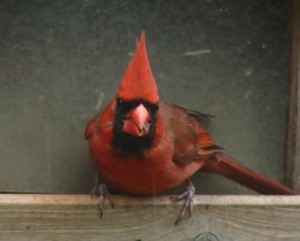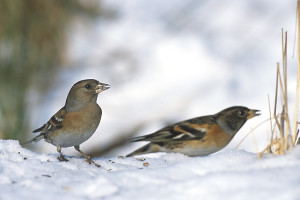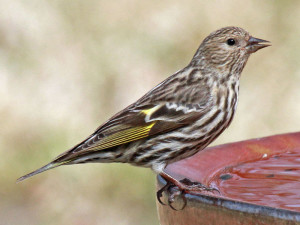A month ago (February 13th) the Cornell Laboratory of Ornithology, Birds Studies Canada and the National Audubon Society sponsored a three day, “citizen’s science” project called “The Great Backyard Bird Count.” This world wide count of birds began in 1998 and has grown in scope and participation with each passing year. Participants are asked to spend fifteen minutes either stationary at some observation point or walking through a habitat counting and identifying the birds they see. Online checklists developed by eBird facilitate the reporting of these observations, and the compilation of the data from the observers seems to be nearly instantaneous!
Here is the link to read this year’s report: http://gbbc.birdcount.org/2015-gbbc-summary/
Some highlights of this year’s count include the total number of checklists submitted (147,265) and the total number of people submitting one or more checklist (143,941). A total of 5,090 species of birds were identified and 18, 726,079 birds were counted! This was, indeed, a very robust survey of birds!
There was a distinct North America bias to this count since about 74% of the checklists came from the United States. The ten most frequently mentioned species on the lists were all North American species (led by the northern cardinal (pictured above) and the dark-eyed junco), and all but one of the top ten most numerous birds in the count were also North American species (the 1,494,937 snow geese topped this list!). The third most numerous species in the count, though, was an Eurasian bird called a brambling.
Bramblings (Fringilla montifringilla) are small finches that summer and breed in the northern forests of Asia and Europe. They then migrate south for the winter (to southern Europe, or northern Africa, Pakistan, India, China or Japan) in large flocks that can number over a million birds. One of these flocks was counted by a Great Backyard Bird Count checklist observer in Germany! The one million birds that this individual estimated the flock of bramblings to number pushed the species (with a total count of 1,000,047) to position number three on the abundant list (well above the 630,610 European starlings!). I think that this reflects the power of the individual even in such a high participation endeavor!
The 2015 count also revealed some interesting changes in the abundances and distribution of many bird species. One species, the pine siskin (Spinus pinus), showed up on 10.5% of the Great Backyard Bird Count checklists this year compared to only 1.2% of the lists from last year! Locally, Lynn Ramage in Armstrong County counted twenty pine siskins at her bird feeders! This “eruption” of pine siskins may be related to the cold, harsh winter which drove the birds slightly further south than usual (right into the heart of the Great Backyard Bird Count observers!), or it may be related to some as yet unknown population cycle in this species. In science, observations lead to explanations and model building, and then experimentation and model re-formulation! I did not see any pine siskins during my counting periods. Possibly, this was due to the fact that several weeks previously I had taken down my thistle (“nyjer”) feeder for cleaning and repair and had yet to put it back up! The pine siskins do love their thistle!
Pennsylvania was second only to California in total number of checklists submitted to the count. Allegheny County led the long list of participating Pennsylvania counties with 101 species and 626 submitted lists. Locally, Westmoreland County submitted 148 lists and counted 68 species, Armstrong County submitted 37 lists and counted 45 species, and Butler County submitted 133 lists and also counted 45 species.
So what is accomplished by this Great Backyard Bird Count? Tracking the pine siskins is interesting. Tracking the southward eruption of the snowy owls is exciting (check out the website!), and just knowing how many birds are out in our wide ranging habitats is important. But maybe most important is getting all of these people outside all at once to look at birds! That is the payoff that is priceless!
The species that I counted for my two Great Backyard Bird Count lists were as common as could be. They all made it onto to top ten “most frequently listed” species. My birding experience didn’t range into wild, exotic discoveries. My birds were cardinals, juncos, blue jays, titmice, chickadees, and crows, and I was very pleased to see them!
Some years ago I was giving a talk at a conference about Deborah’s and my Virtual Nature Trail and the actual, physical nature trail on our campus that was the inspiration for it. At the end of my presentation I was asked a question, “what was special, or unique about this nature trail?” I sensed an undertone to the question of “why would anyone want to go see this trail?” Usually you come up with answers to questions like this much later, but somehow I found the answer right away: There is nothing particularly unique or “special” about this trail, and this is what made it so important. It is the beauty in the ordinary, as Bill Bryson once put it “the low level ecstasy” of the common species and common terrain that make this site so wonderful. Sitting back and seeing what is around you in nature always elevates and inspires you!
And, to me, this is what makes the Great Backyard Bird Count and the sight of all of those ordinary birds that every day gobble down my sunflower seeds, corn, peanuts and thistle, so amazing.




I also smiled at the reminder to find “beauty in the ordinary.” Love that amazing photo Deborah took of the cardinal, too!
We think we have a barred owl couple roosting in the pine trees near our house and are hoping we might get to glimpse some owlets this spring. Mostly we just hear their great “who cooks for you?” hooting. Magic!
I liked the comment “it is the beauty in the ordinary”.